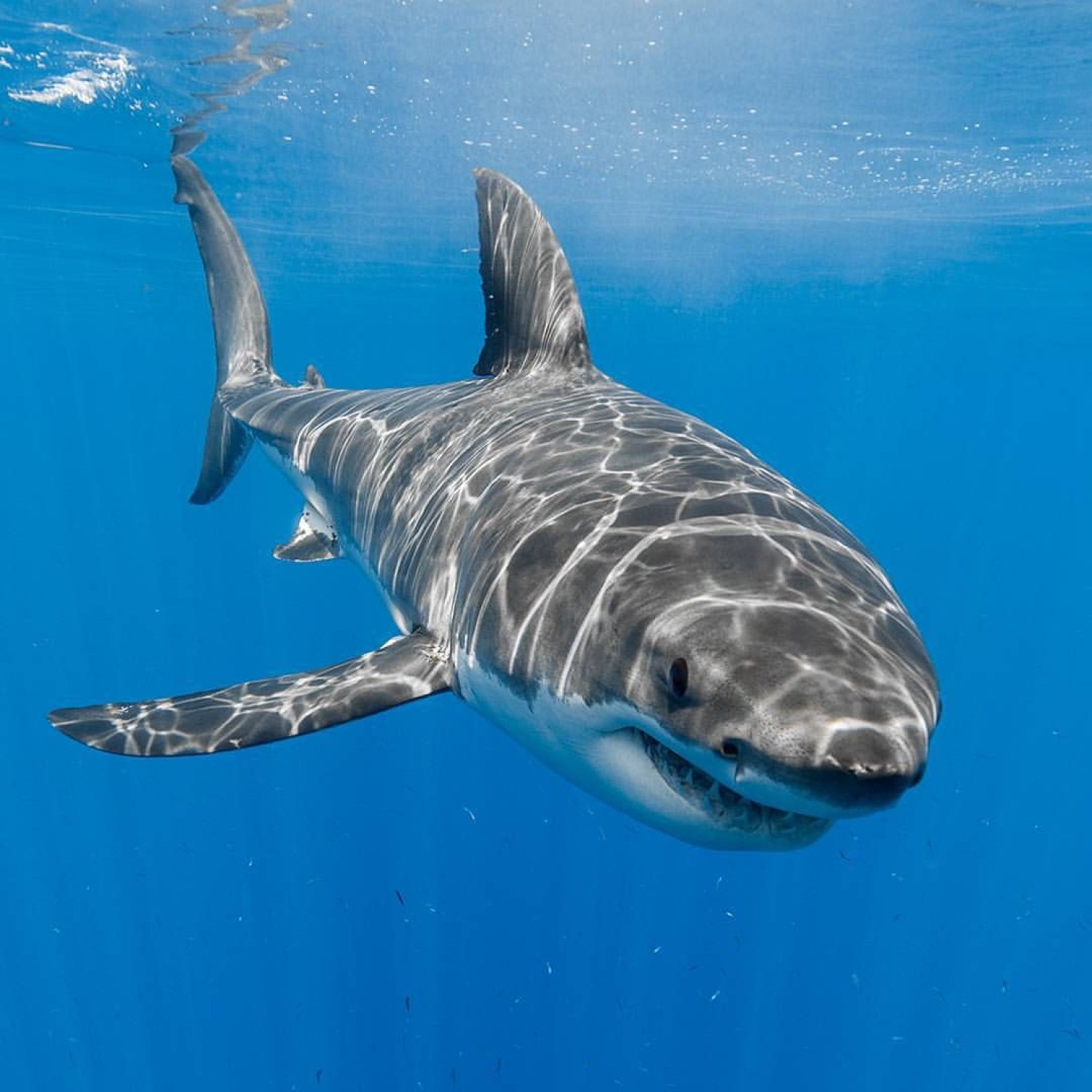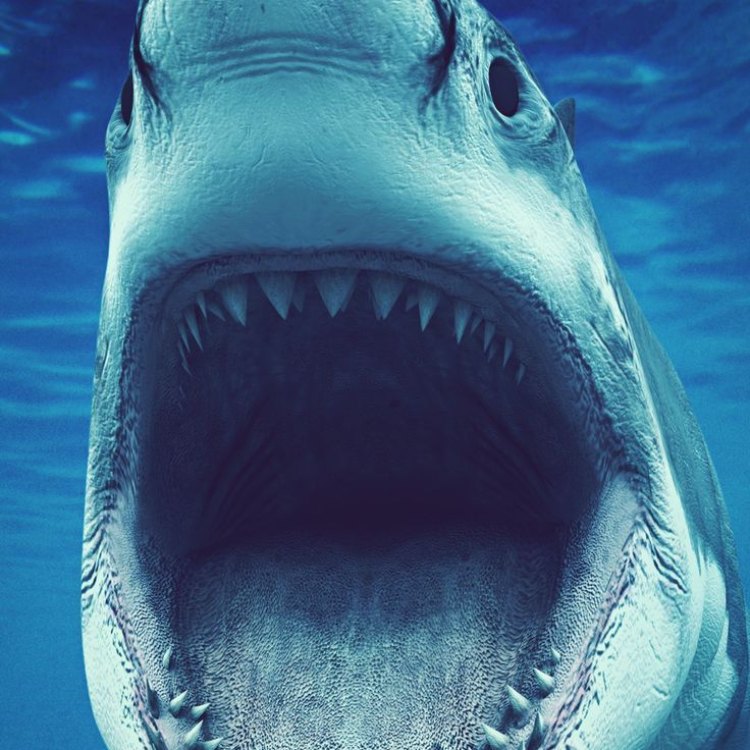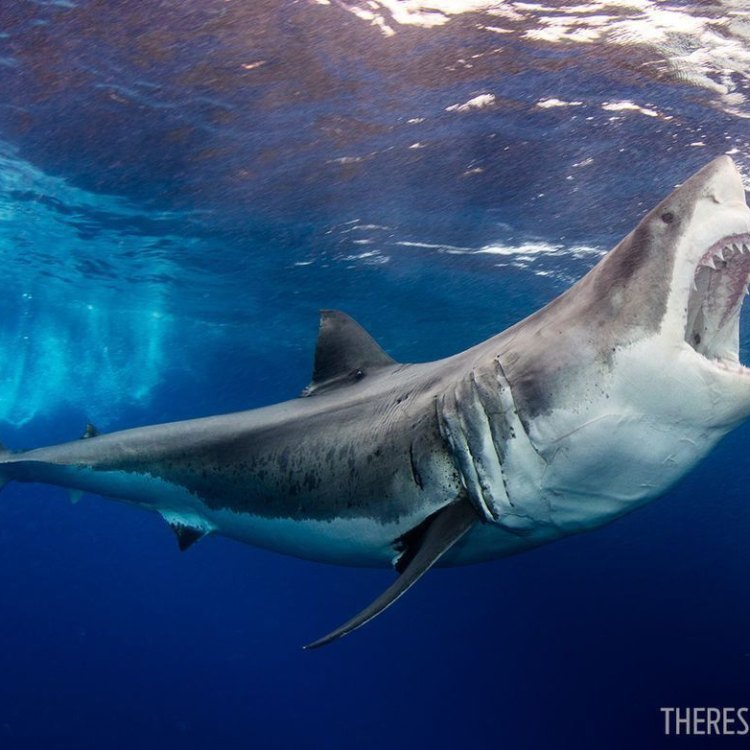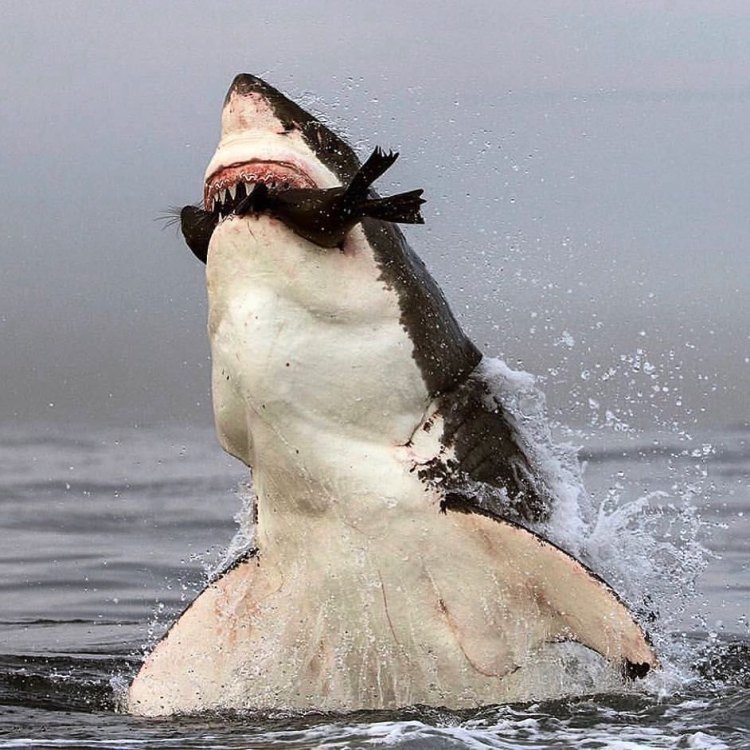
White Shark
Female: Up to 15 feet (4.6 meters), Male: Up to 13 feet (4 meters)
The White Shark, also known as the Great White, can grow up to 15 feet for females and 13 feet for males. They are found in saltwater and belong to the Lamnidae family. These mighty creatures have a streamlined and torpedo-shaped body, making them one of the most efficient and deadly predators in the ocean. #whiteshark #greatwhite #oceanpredator
Animal Details Summary:
Common Name: White Shark
Kingdom: Animalia
Habitat: Marine
The Fierce and Fascinating White Shark: A Closer Look at the King of the Ocean
When we think of sharks, the first image that comes to mind is often that of a ferocious and feared predator – the White Shark. This magnificent creature has captured the imagination of humans for centuries, instilling both fear and fascination with its powerful presence in the ocean. From its iconic appearance to its incredible abilities, the White Shark is a creature that commands respect and awe. Let's take a closer look at this magnificent creature White Shark.The Basics: Meet the White Shark
The White Shark, also known by its scientific name Carcharodon carcharias, is a member of the animal kingdom, phylum Chordata, and class Chondrichthyes. This impressive creature belongs to the order Lamniformes and the family Lamnidae. It is the largest predatory fish in the sea and can be found in oceans worldwide. The White Shark has a streamlined and torpedo-shaped body, which allows it to glide easily through the water. Its body is typically grey on top and white on the belly, giving it its iconic appearance.Habitat and Diet
As a marine animal, the White Shark spends its entire life in the ocean. It can be found in both warm and temperate waters, with a preference for coastal and offshore regions. These sharks are known for their wide-ranging habitats and have been observed in depths of up to 6,000 feet (1,800 meters). They are highly migratory and can be found crossing entire oceans Woolly Bear Caterpillar.When it comes to their diet, White Sharks are apex predators, meaning they are at the top of the food chain. As carnivores, they feed on a variety of prey, including fish, dolphins, seals, sea lions, and even other sharks. They use their sharp and serrated teeth to tear off chunks of flesh from their prey, and their powerful jaw muscles help them deliver a devastating bite. White Sharks are also known for their incredible hunting abilities, with the ability to ambush their prey from below, reaching speeds of up to 35 miles per hour (56 kilometers per hour).
Geographical Distribution and Country of Origin
As mentioned earlier, White Sharks can be found in all major oceans worldwide, including the Atlantic, Indian, and Pacific oceans. However, they are more commonly found in temperate and tropical waters, where prey is more abundant. While they have been observed in many countries, including the United States, Australia, South Africa, and Mexico, it is difficult to determine their country of origin due to their wide-ranging habits.Must-Know Facts About the White Shark
Now that we have covered the basics let's take a look at some interesting facts about the White Shark that make it truly one of a kind.- The White Shark's scientific name, Carcharodon carcharias, translates to "jagged-toothed, ragged-toothed."
- These sharks have a unique organ called the ampullae of Lorenzini, which helps them detect prey through the electrical signals they emit.
- Studies have shown that White Sharks can detect one drop of blood in a volume of water equal to an Olympic-sized swimming pool.
- The average lifespan of a White Shark is estimated to be around 30-40 years.
- In 2013, a Great White named "Deep Blue" was recorded as the largest shark ever filmed, measuring up to 20 feet (6.1 meters) in length.
- Contrary to popular belief, White Sharks do not mistake humans for seals or other prey. Human attacks are usually due to cases of mistaken identity or curiosity.
- White Sharks have a remarkable healing ability, with wounds healing faster in saltwater than in freshwater.
- These sharks have a keen sense of smell, with the ability to detect a drop of blood from up to three miles away.
The White Shark and Humans
Throughout history, humans have had a complex relationship with White Sharks. On one hand, we are fascinated by these majestic creatures and their place at the top of the ocean's food chain. On the other hand, we fear them due to their powerful and often misunderstood nature.While White Sharks have been involved in attacks on humans, they are not considered to be a major threat. According to the International Shark Attack File, there have been around 318 confirmed unprovoked attacks by White Sharks on humans, with only 80 of them resulting in death. This pales in comparison to the estimated 100 million sharks killed every year by humans.
So why are we so afraid of White Sharks? The answer lies in our own perceptions and exaggerated media portrayals of these creatures. As apex predators, sharks serve an essential role in maintaining the balance of marine ecosystems. And contrary to popular belief, White Sharks are not indiscriminate killers, but instead, they play a vital role in keeping populations of other marine animals in check.
The Conservation Status of White Sharks
While White Sharks may seem invincible, they are facing a variety of threats that put their survival at risk. One of the biggest threats comes from humans, who often hunt them for their fins, meat, and liver oil. This practice is known as finning, and it has significantly decreased White Shark populations.Moreover, these sharks also face other threats, such as habitat loss and degradation, pollution, noise pollution, climate change, and accidental entanglement in fishing gear. As a result, White Sharks have been listed as "vulnerable" on the International Union for Conservation of Nature (IUCN) Red List, meaning they are at high risk of extinction without conservation measures.
Fortunately, some measures are being taken to protect White Sharks. In many countries, including the United States and Australia, these sharks are protected by laws that regulate fishing and prohibit the hunting of White Sharks. Other conservation efforts include research, education, and awareness programs, as well as the establishment of marine protected areas.
Final Thoughts
Despite their fearsome reputation, White Sharks are not the ruthless predators they are often made out to be. They are magnificent creatures, perfectly adapted to their ocean habitat and playing a crucial role in maintaining the balance of marine ecosystems.As we continue to learn more about these creatures, it is essential for us to shift our perceptions and approach towards them. By understanding and respecting the White Shark and other marine animals, we can work towards preserving their populations and ensuring their survival for generations to come.

White Shark
Animal Details White Shark - Scientific Name: Carcharodon carcharias
- Category: Animals W
- Scientific Name: Carcharodon carcharias
- Common Name: White Shark
- Kingdom: Animalia
- Phylum: Chordata
- Class: Chondrichthyes
- Order: Lamniformes
- Family: Lamnidae
- Habitat: Marine
- Feeding Method: Carnivore
- Geographical Distribution: Oceans worldwide
- Country of Origin: Not applicable
- Location: Saltwater
- Animal Coloration: Grey on top, white on the belly
- Body Shape: Streamlined and torpedo-shaped
- Length: Female: Up to 15 feet (4.6 meters), Male: Up to 13 feet (4 meters)

White Shark
- Adult Size: Female: Up to 20 feet (6 meters), Male: Up to 16 feet (4.9 meters)
- Average Lifespan: Up to 70 years
- Reproduction: Sexual
- Reproductive Behavior: Internal fertilization
- Sound or Call: Not applicable
- Migration Pattern: Some individuals migrate long distances
- Social Groups: Solitary
- Behavior: Apex predator, mainly hunts marine mammals
- Threats: Overfishing, bycatch, habitat destruction, and climate change
- Conservation Status: Vulnerable
- Impact on Ecosystem: Maintains balance in marine ecosystems
- Human Use: Fisheries, trophy hunting, tourism
- Distinctive Features: Large size, triangular and serrated teeth
- Interesting Facts: One of the largest predatory fish in the world
- Predator: No natural predators

Carcharodon carcharias
The Magnificent White Shark: An Apex Predator of the Ocean
In the vast and mysterious world of the ocean, there is one species that has captured the attention and fear of humans for centuries - the White Shark. Known for its sheer size and fearsome reputation, this apex predator has long been a source of fascination and intrigue. From its massive size to its unique reproductive behavior, there are many distinctive features that make the White Shark stand out among other marine animals. In this article, we will delve into the world of the White Shark, exploring its biology, behavior, and impact on the ecosystem PeaceOfAnimals.Com.Classification and Physical Characteristics
Scientifically known as Carcharodon carcharias, the White Shark belongs to the Lamniformes order, which includes other well-known species such as mackerel and salmon sharks. It is part of the Lamnidae family, which also includes the famous Great White Shark. They are found in all major oceans and have a distribution range from the surface to depths of up to 3,927 feet (1,197 meters).
The most distinctive feature of the White Shark is its size. On average, adults can reach up to 20 feet (6 meters) in length, with females being larger than males. Females can grow up to 4 feet longer than males, reaching a maximum length of 20 feet, while males can grow up to 16 feet (4.9 meters) in length. They can weigh anywhere from 1,500 to 2,500 pounds (680 to 1,130 kilograms). However, some individuals have been recorded to weigh over 6,500 pounds (2,948 kilograms), making it one of the largest predatory fish in the world Wood Tick.
Another distinctive physical feature is the White Shark's teeth. They have multiple rows of sharp, triangular, and serrated teeth that can grow up to 2.5 inches (6.35 centimeters) in length. The teeth are constantly being replaced throughout the shark's lifetime, with a single shark losing up to 20,000 teeth in its lifetime. This allows them to maintain their sharp and formidable hunting tools.
Reproductive Behavior and Mating
White Sharks are sexual reproducers, with females reaching sexual maturity at around 12 to 14 years of age, while males reach sexual maturity at around 7 to 9 years of age. Interestingly, the White Shark has a unique reproductive tactic known as internal fertilization. This means that the male's reproductive organ, called a "clasper," is inserted into the female's reproductive tract to fertilize the eggs. This is different from most fish, where the female releases eggs into the water, and the male fertilizes them externally.
The mating process for White Sharks is still a mystery, as they are solitary creatures and do not mate in groups. However, it is believed that mating behavior may involve a male "courting" a female by biting her, or "hitting" her with his head. This behavior may signal his interest and intent to mate.
After a successful mating, the female will give birth to live young, known as "pups." A pregnant female can carry between 2 to 10 pups at a time, with a gestation period of 11 to 12 months. The newborn pups are around 5 feet (1.5 meters) in length and are fully capable of hunting and surviving on their own. This is a crucial aspect of White Shark biology, as it ensures that the species can continue to thrive and reproduce even if a significant number of adult sharks are lost due to factors such as hunting or accidental capture.
Behavior and Hunting Habits
As apex predators, White Sharks play a crucial role in maintaining the balance of marine ecosystems. They are opportunistic feeders, meaning they will eat a variety of prey, depending on what is available. Their main diet consists of marine mammals such as seals, sea lions, and small whales, which they have to actively hunt and kill. However, they are known to also feed on other marine animals such as fish, turtles, and even other sharks.
The White Shark's hunting strategy is to ambush its prey from below, using its sharp teeth to deliver a deadly bite. They have incredible speed and agility, capable of reaching speeds of up to 35 miles per hour (56 kilometers per hour) in short bursts. They also have a unique hunting technique called "spy-hopping," where they will raise their head out of the water to get a better view of their surroundings before diving back down to continue their hunt.
Aside from hunting, White Sharks are also solitary creatures and are typically not found in groups or socializing with other sharks. This behavior is thought to be due to their territorial nature, as well as the competitive and aggressive behavior of males during the mating season.
Threats and Conservation Status
Despite their fearsome reputation, White Sharks are facing significant threats, mainly due to human activities. These include overfishing, bycatch, habitat destruction, and climate change. The demand for shark fin soup and shark liver oil in some parts of the world has led to a rapid decline in White Shark populations. Additionally, their slow reproductive rate and long lifespan (up to 70 years) make them particularly vulnerable to these threats and slow to recover.
As a result, the International Union for Conservation of Nature (IUCN) has listed the White Shark as "Vulnerable" on the Red List of Threatened Species. This means that they face a high risk of extinction in the wild if effective conservation actions are not taken. Thankfully, there are efforts being made to protect and conserve White Sharks, such as implementing fishing regulations and establishing marine protected areas where their populations can thrive.
Impact on the Ecosystem
As apex predators, White Sharks play a crucial role in maintaining the health and balance of marine ecosystems. They help to regulate the population of prey species, which in turn, helps to control the food web. In areas where White Sharks have been overfished or depleted, there have been noticeable shifts in the ecosystem, such as increased numbers of prey species and decreased biodiversity.
Moreover, the presence of White Sharks also influences the behavior and movements of other marine animals. For example, seals and other prey species may alter their hunting and migration patterns to avoid areas where White Sharks are known to be present. This creates a ripple effect on the ecosystem, demonstrating the profound impact that White Sharks have on the ocean's delicate balance.
Human Use and Interesting Facts
Throughout history, White Sharks have been feared and revered by humans. They are often portrayed in books, movies, and other media as vicious man-eaters, further perpetuating their negative reputation. However, the truth is that White Sharks rarely attack humans, with only a handful of fatal attacks recorded each year. In fact, humans are more likely to be injured by lightning than attacked by a White Shark.
Despite their fearsome reputation, White Sharks have also been the subject of human use, including fisheries, trophy hunting, and tourism. Fishing for White Sharks is allowed in some countries, such as Australia and South Africa, where there is a regulated and monitored industry for shark-based products. Trophy hunting, where a White Shark is caught and killed for sport, is also practiced in some areas. However, this is controversial, as the impact of altering the population of such a crucial species is not fully understood.
On the other hand, White Shark tourism has become increasingly popular in recent years. It involves taking tourists on guided trips to see and interact with White Sharks in their natural habitat. This form of non-consumptive and sustainable tourism is considered a more ethical and beneficial way to engage with these magnificent creatures.
One of the most interesting facts about the White Shark is that it has no natural predators. Due to their large size, sharp teeth, and powerful physical abilities, they are at the top of the food chain and have no need to fear any predators. The only threat they face is from humans, highlighting the importance of conservation efforts to ensure their survival and continued contributions to the ocean's ecosystem.
In conclusion, the White Shark is a remarkable and iconic species that holds a unique place in the ocean's complex web of life. From its physical characteristics and reproductive behavior to its crucial role in marine ecosystems, this apex predator continues to fascinate and intrigue us. As humans, it is our responsibility to protect and conserve White Sharks, ensuring that future generations can also marvel at their magnificence and appreciate their importance in the ocean.

The Fierce and Fascinating White Shark: A Closer Look at the King of the Ocean
Disclaimer: The content provided is for informational purposes only. We cannot guarantee the accuracy of the information on this page 100%. All information provided here may change without prior notice.












